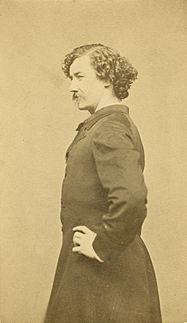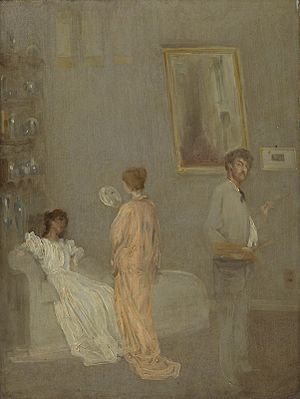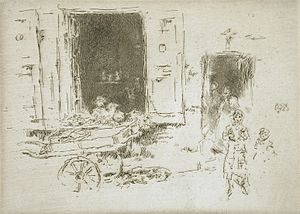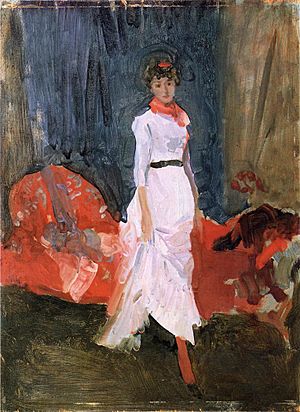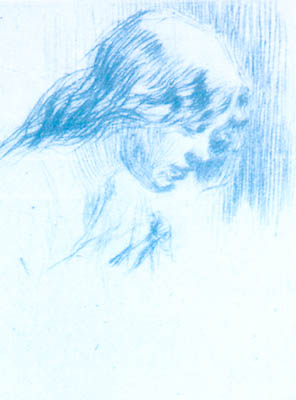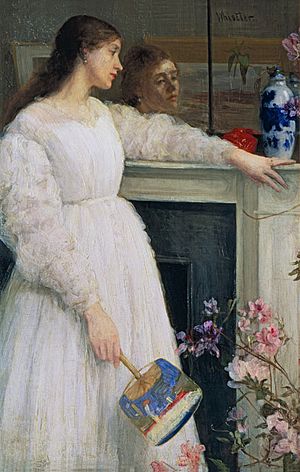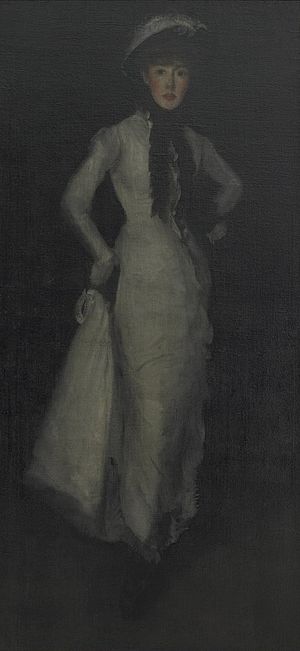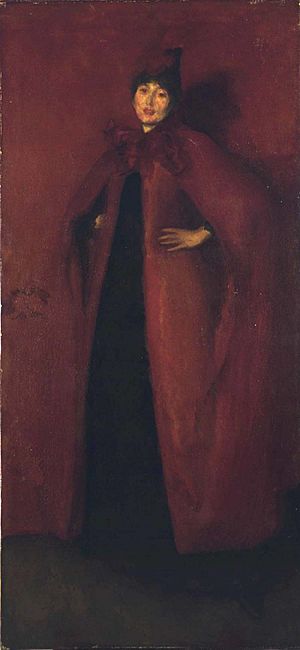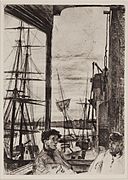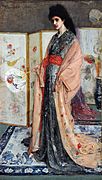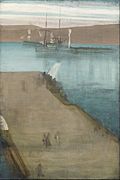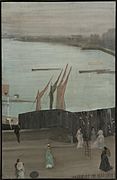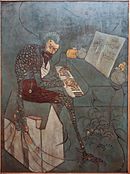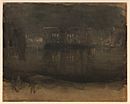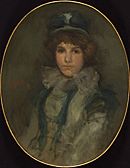James Abbott McNeill Whistler facts for kids
Quick facts for kids
James Abbott McNeill Whistler
|
|
|---|---|
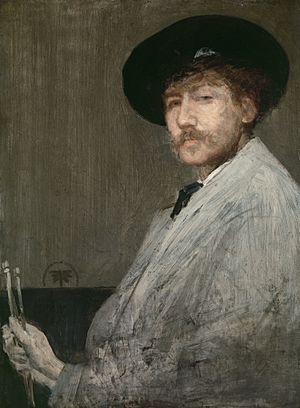
Arrangement in Gray: Portrait of the Painter
(self portrait, c. 1872), Detroit Institute of Arts |
|
| Born | July 10, 1834 |
| Died | July 17, 1903 (aged 69) London, England, UK
|
| Nationality | American |
| Education | United States Military Academy, West Point, New York |
| Known for | Painting |
|
Notable work
|
Whistler's Mother |
| Movement | Founder of Tonalism |
| Spouse(s) | |
| Awards |
|
James Abbott McNeill Whistler (July 10, 1834 – July 17, 1903) was an American painter. He lived mostly in the United Kingdom. Whistler believed that art should be beautiful for its own sake. He called this idea "art for art's sake".
His paintings often had musical names like "arrangements" or "nocturnes". This showed how he saw a connection between painting and music. His most famous painting is Arrangement in Grey and Black No. 1 (1871). It is commonly known as Whistler's Mother. It is a very famous portrait of motherhood. Whistler's ideas and friendships with other artists influenced the art world of his time.
| Top - 0-9 A B C D E F G H I J K L M N O P Q R S T U V W X Y Z |
Early Life and Art Training
Growing Up in America and Europe
James Abbott Whistler was born in Lowell, Massachusetts, on July 10, 1834. His father, George Washington Whistler, was a railroad engineer. His mother was Anna McNeill Whistler. The family moved often because of his father's work.
In 1842, his family moved to St. Petersburg, Russia. His father worked on a railroad there. James started taking private art lessons at age eleven. He even enrolled in the Imperial Academy of Arts. A famous artist, Sir William Allan, noticed James's talent. He told James's mother, "Your little boy has uncommon genius."
In 1847, the family spent time in London. James's brother-in-law, Francis Seymour Haden, encouraged his interest in art. James began to collect art books and study different painting styles. At fifteen, he told his father he wanted to be an artist. Sadly, his father died soon after. The family moved back to Pomfret, Connecticut.
Learning at West Point
Whistler later applied to the United States Military Academy at West Point. His father had taught drawing there. James was accepted in 1851. He studied drawing and map making from artist Robert W. Weir. However, James struggled with other subjects and rules. He was dismissed from West Point after three years.
First Job and Moving to Paris
After West Point, Whistler worked mapping the U.S. coast. He found the work boring. He was often late or absent. He learned etching, which was useful for his art career.
Whistler decided that art was his future. He moved to Paris in 1855 to study art. He rented a studio and lived like an artist. He studied traditional art methods for a short time. He learned that line was more important than color. He also learned that black was a key color for creating harmony in paintings.
He often spent more money than he had. To earn money, he copied paintings from the Louvre museum. In 1858, he met Henri Fantin-Latour. Through him, Whistler joined a group of artists like Gustave Courbet and Édouard Manet. He was also influenced by Charles Baudelaire, who believed artists should show real life.
Moving to London
In 1859, Whistler moved to London, which became his main home. He still visited friends in France. He painted At the Piano in London. It showed his niece and her mother in their music room. Critics praised his talent for color and design. The painting showed his skill in using a limited set of colors.
He also created etchings of the River Thames. He started to develop his style of using specific colors to create a harmonious look.
Developing His Art Style
In 1861, Whistler painted Symphony in White, No. 1: The White Girl. It was a portrait of his model, Joanna Hiffernan. He wanted it to be a simple study in white. However, people saw different meanings in it. Some thought it was about lost innocence.
The painting was rejected by the Royal Academy in England. But it was shown at the Salon des Refusés in Paris in 1863. This was a special exhibit for artworks rejected by the main art show. Whistler's painting gained a lot of attention. His supporters said it showed his idea that art should focus on colors and harmony, not just telling a story.
Two years later, he painted another portrait of Hiffernan, The Little White Girl. This painting showed his interest in Asian art. In 1864, Whistler's religious mother moved to London. This changed his free-spirited lifestyle. He moved Hiffernan to another place. From 1866, Whistler lived in Chelsea, London, a popular area for artists.
Nocturnes: Paintings Like Music
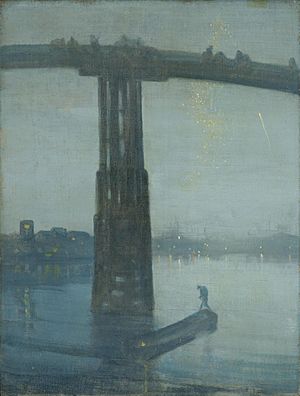
In 1866, Whistler traveled to Valparaíso, Chile. This trip led to his first "nocturne" paintings. These were night scenes of the harbor, painted with cool blue or green colors. After returning to London, he painted many more nocturnes. Many showed the River Thames or Cremorne Gardens, a park known for fireworks. He used thin paint to suggest ships, lights, and shorelines. Some of his Thames paintings looked similar to Japanese prints.
In 1872, Whistler started giving his paintings musical titles. He called them "nocturnes," "symphonies," or "harmonies." This was to show that the colors and composition were most important, not the story. His nocturnes were very new and different.
Famous Portraits
Whistler's Mother
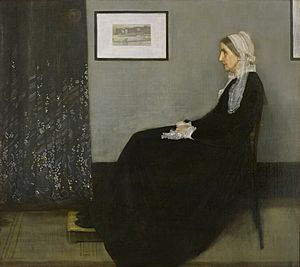
In 1871, Whistler painted his most famous work, Arrangement in Grey and Black No.1. It is known as Whistler's Mother. One day, a model didn't show up. So, Whistler asked his mother to pose for him. It took many sittings to finish the painting.
The painting is simple and uses a limited range of colors. It shows Whistler's skill in balancing different shapes. Whistler said the story of the painting wasn't important. But it also honored his mother. She helped him by bringing stability to his home.
At first, people didn't like the painting. They thought it was too simple for the time. The Royal Academy rejected it at first. But they later accepted it and hung it in a less noticeable spot.
Over time, Whistler's Mother became very famous. It has been parodied and honored. During the Great Depression in the United States, it was called a "million dollar" painting. It was a big hit at the 1933–34 Chicago World's Fair. People around the world saw it as a symbol of motherhood. In 1934, the United States even put it on a postage stamp.
Other Important Portraits
Whistler painted other important portraits. These included ones of historian Thomas Carlyle (1873) and socialite Lady Meux (1882). In the 1870s, he painted Frederick Richards Leyland and his wife. Leyland later asked Whistler to decorate his dining room.
Whistler was often unhappy with how his paintings were shown at the Royal Academy. So, in 1874, he held his first solo art show. He designed the exhibition hall to match his paintings. This created a sense of harmony.
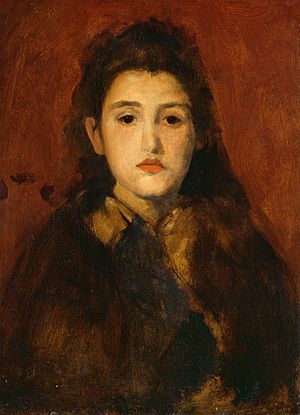
Whistler was not as popular a portrait painter as John Singer Sargent. This was partly because he worked slowly. He also didn't try to make his subjects look more flattering. One sitter complained that Whistler was a "tyrant" who demanded very long sittings.
Printmaking Skills
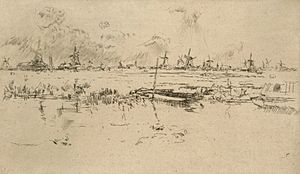
Whistler was also a master of printmaking. He made many etchings, lithographs, and dry-points. His etchings included portraits and street scenes in London and Venice. He became very famous as an etcher. Some art experts even compared him to Rembrandt.
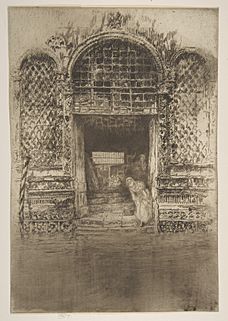
He was very careful about how his etchings were printed. He chose the paper and how the ink was applied.
Butterfly Signature and Art Philosophy
Whistler's famous butterfly signature started in the 1860s. He was interested in Asian art. He designed a symbol from his initials. Over time, it became an abstract butterfly. Around 1880, he added a stinger to it. This symbol showed both his gentle artistic side and his strong, sometimes fighting, personality. He carefully placed this signature on his paintings and frames.
Whistler believed that the way a painting was displayed was important. He thought the setting should match the art. This idea led to his most famous decorative work, The Peacock Room.
The Peacock Room
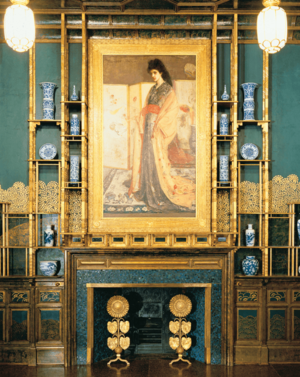
Harmony in Blue and Gold: The Peacock Room is Whistler's most famous decorative artwork. He painted it in 1876–1877. It is a room decorated in brilliant blue-greens and gold. It is a great example of the Anglo-Japanese style.
Frederick Leyland, a wealthy collector, asked Whistler to make small changes to his dining room. The room was meant to display Leyland's china collection. But Whistler got carried away. He painted over the original walls. He said, "I just painted on. I went on—without design or sketch—putting in every touch with such freedom." He created a beautiful, unified space.
Later, an American collector named Charles Lang Freer bought the entire room in 1904. He had it moved to his mansion in Detroit. After Freer's death, The Peacock Room was permanently installed at the Freer Gallery of Art in Washington, D.C.
The Ruskin Trial
In 1877, Whistler sued art critic John Ruskin for libel. Ruskin had strongly criticized Whistler's painting, Nocturne in Black and Gold: The Falling Rocket. Ruskin wrote that Whistler had "flung a pot of paint in the public's face."
Whistler wanted to clear his name and get money for the damage to his reputation. The trial happened in 1878. Many artists were afraid to support Whistler. The jury sided with Whistler but only awarded him a tiny amount of money. The trial costs, along with debts from building his house, led to Whistler going bankrupt in 1879. He had to sell his art and possessions.
Whistler wrote about the trial in a book called The Gentle Art of Making Enemies. The trial made him lose popularity with some art buyers.
Later Years and Legacy
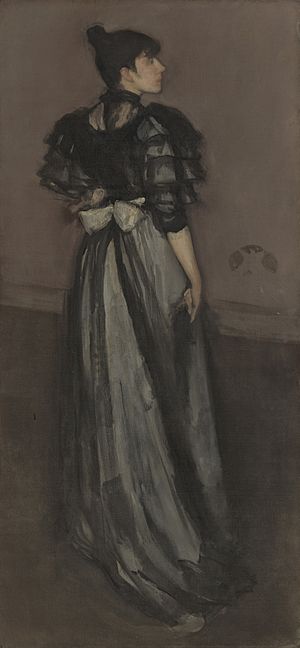
After the trial, Whistler went to Venice to create etchings. He spent fourteen months there. He made over fifty etchings, many pastels, and watercolors. He captured the mood and details of Venice. These works helped him financially.
Back in London, Whistler gained admiration from younger artists. They looked up to him and called themselves "pupils of Whistler." He published his book, Ten O'Clock lecture, in 1885. In it, he explained his belief in "art for art's sake." He said that art should be beautiful on its own, not just teach a lesson. He also believed that artists should improve upon nature with their own vision.
In 1886, Whistler became president of the Society of British Artists. He even helped the society get the title "Royal" from Queen Victoria. However, he later had disagreements with other members and resigned.
In 1888, Whistler married Beatrice Godwin. She was a former student and the widow of his architect. Their marriage was happy for several years.
Whistler's reputation grew in London and Paris. In 1890, he met Charles Lang Freer, who became an important collector of his art in America. In 1891, the French government bought Whistler's Mother.
In 1892, Whistler and Beatrice moved to Paris. He was at the peak of his career. Sadly, Beatrice became ill with cancer. They returned to London in 1896, and she died a few months later. Her death was a great loss for Whistler.
Whistler continued to paint and correspond with friends. He died in London on July 17, 1903, at age 69. He is buried in Chiswick Old Cemetery.
Whistler's friends, Joseph and Elizabeth Robins Pennell, wrote a biography about him in 1908. His art and belongings were left to his sister-in-law, Rosalind Birnie Philip. Much of it was later given to Glasgow University.
Personal Connections
Whistler had a unique look and personality. He was short and thin, with sharp eyes and a mustache. He often wore a monocle and fancy clothes. He was known for being confident and sometimes arrogant. He loved to surprise people and argue for his strong art ideas.
Whistler was famous for his quick wit. He often had witty exchanges with his friend and rival, Oscar Wilde. They were both well-known figures in Paris society.
Whistler was friends with many French artists, including Henri Fantin-Latour and Gustave Courbet. He also knew Édouard Manet and the Impressionists, like Monet and Edgar Degas. As a young artist, he was close friends with Dante Gabriel Rossetti.
His model, Joanna Hiffernan, also posed for other artists. Later, he lived with his model and partner, Maud Franklin, for many years. She helped him develop his portrait skills by posing for long periods.
Lasting Impact
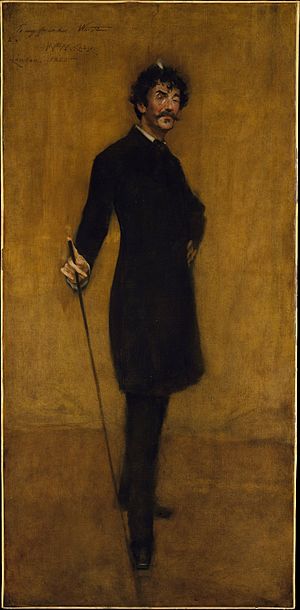
Whistler was inspired by many artists, including Rembrandt and Velázquez. He created his own unique and influential style. He worked in many art forms, including paintings, etchings, and watercolors.
He was a leader in the Aesthetic Movement. He promoted the idea of "art for art's sake." He taught his students to use simple designs and harmonious colors. Whistler believed artists should interpret what they saw, not just copy reality. He said their job was to "bring forth from chaos glorious harmony."
Whistler influenced two generations of artists in Europe and the United States. His style, called Tonalism, had a big effect on American artists like John Singer Sargent and William Merritt Chase. His time in Venice also changed how artists viewed and painted the city.

Honored on Issue of 1940
In 1940, Whistler was honored on a United States postage stamp.
Whistler's personality and ideas also influenced literature. He was the basis for characters in novels by Henry James and Marcel Proust.
The house where Whistler was born is now the Whistler House Museum of Art.
Honors and Recognition
Whistler received many awards during his life:
- 1884: Became an honorary member of the Royal Academy of Fine Arts in Munich.
- 1892: Was made an officer of the Légion d'honneur in France.
- 1898: Became a founding member and first president of the International Society of Sculptors, Painters and Gravers.
A statue of James McNeill Whistler was put up in 2005. It is near the Battersea Bridge in London.
Gallery
See also
 In Spanish: James McNeill Whistler para niños
In Spanish: James McNeill Whistler para niños
- John Wharlton Bunney
- Western painting




